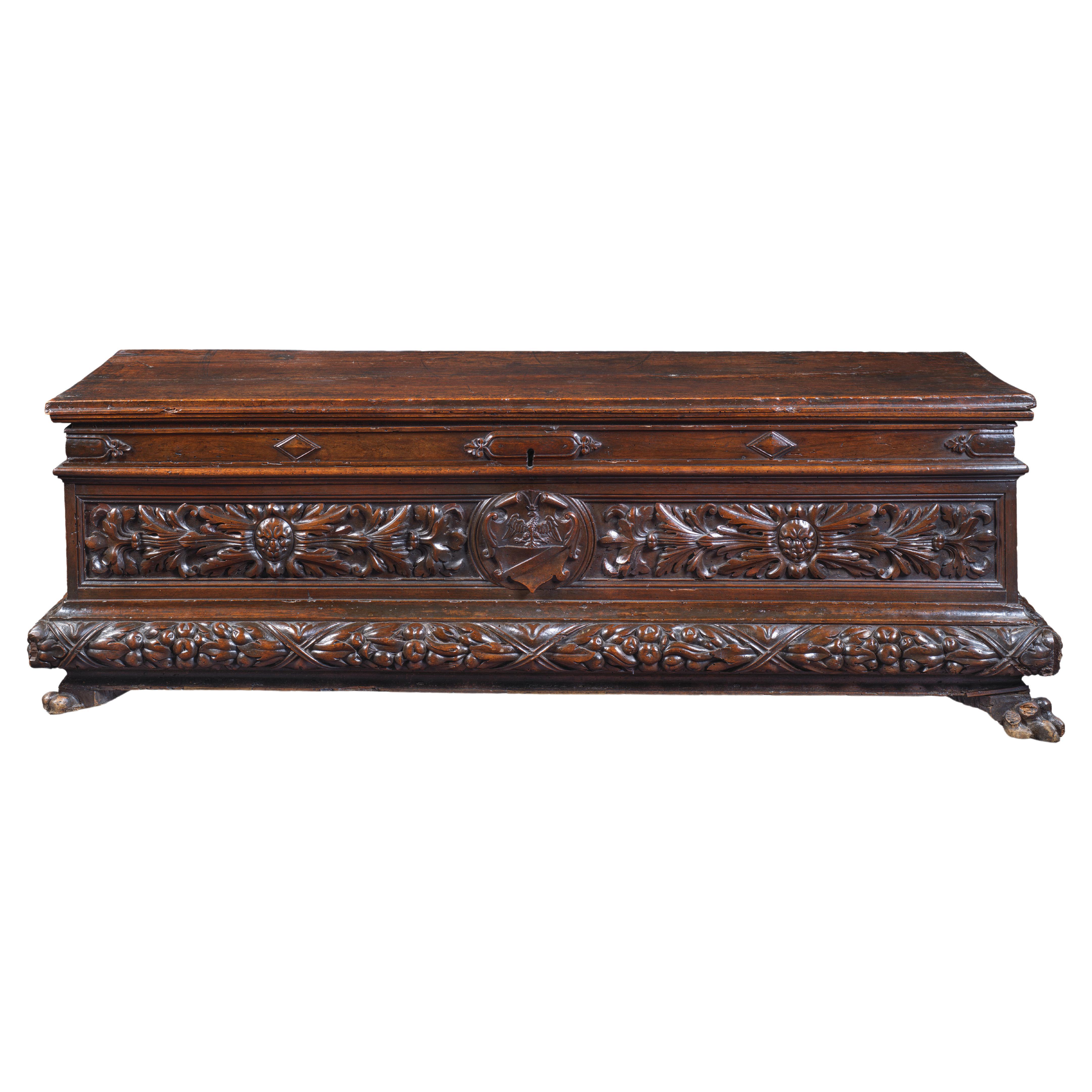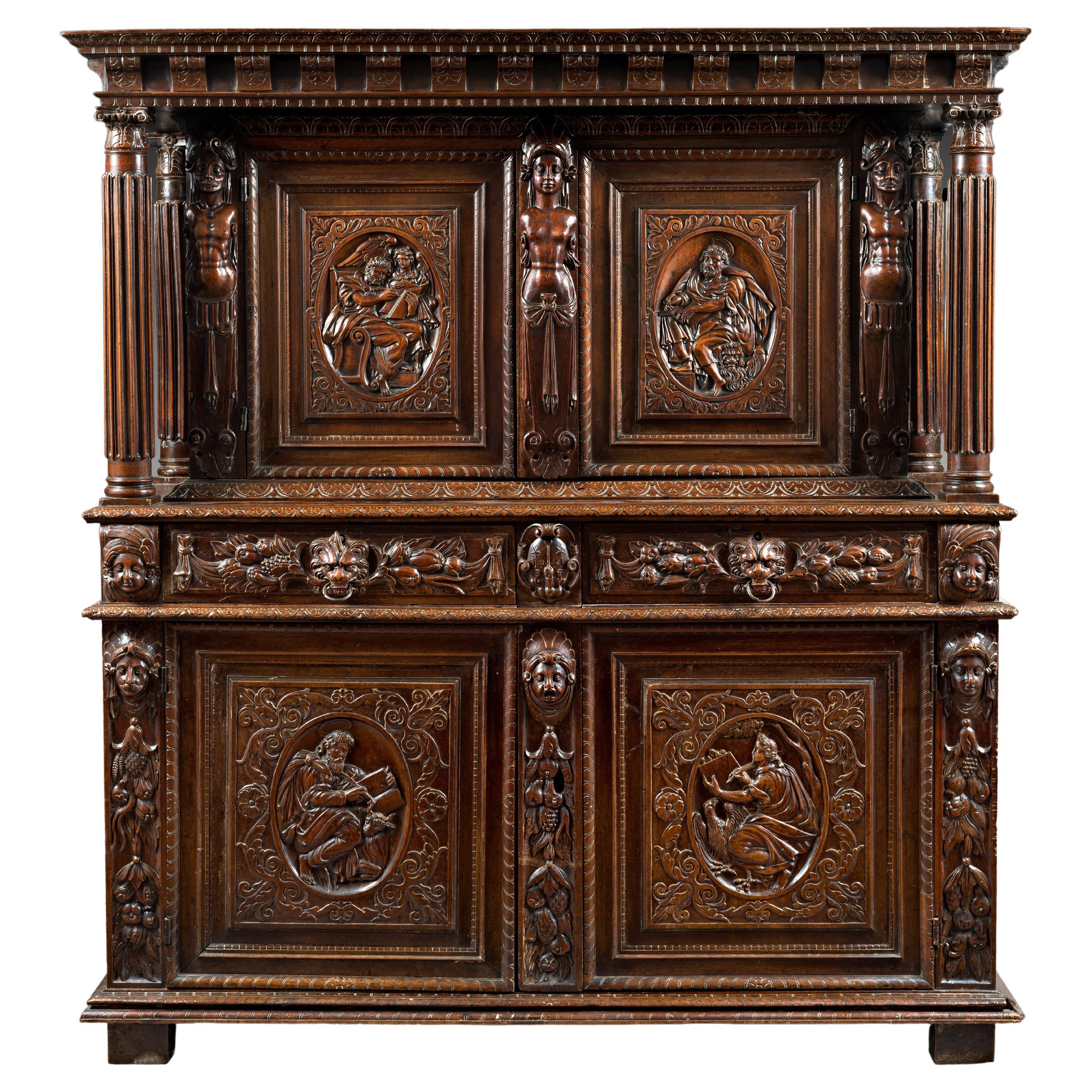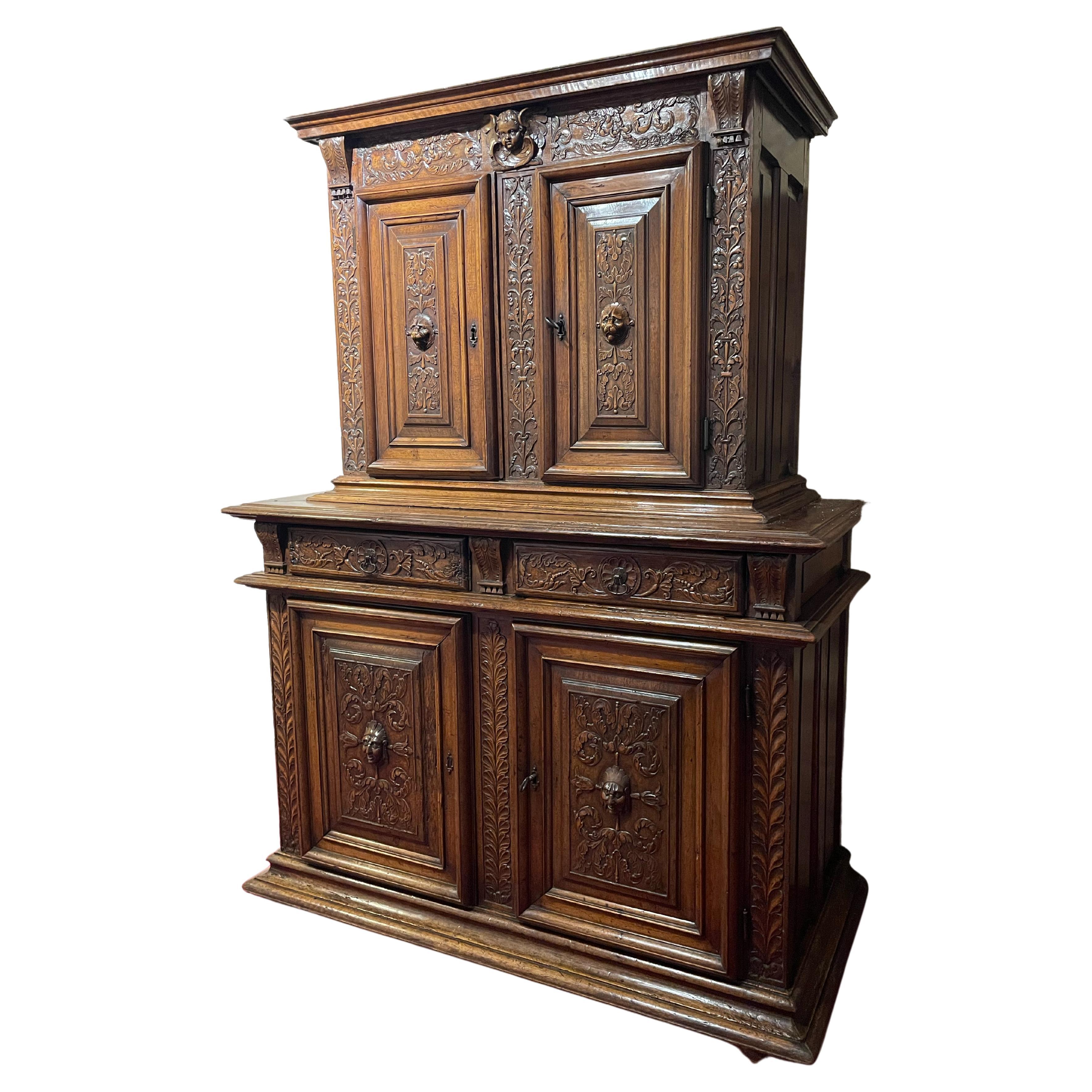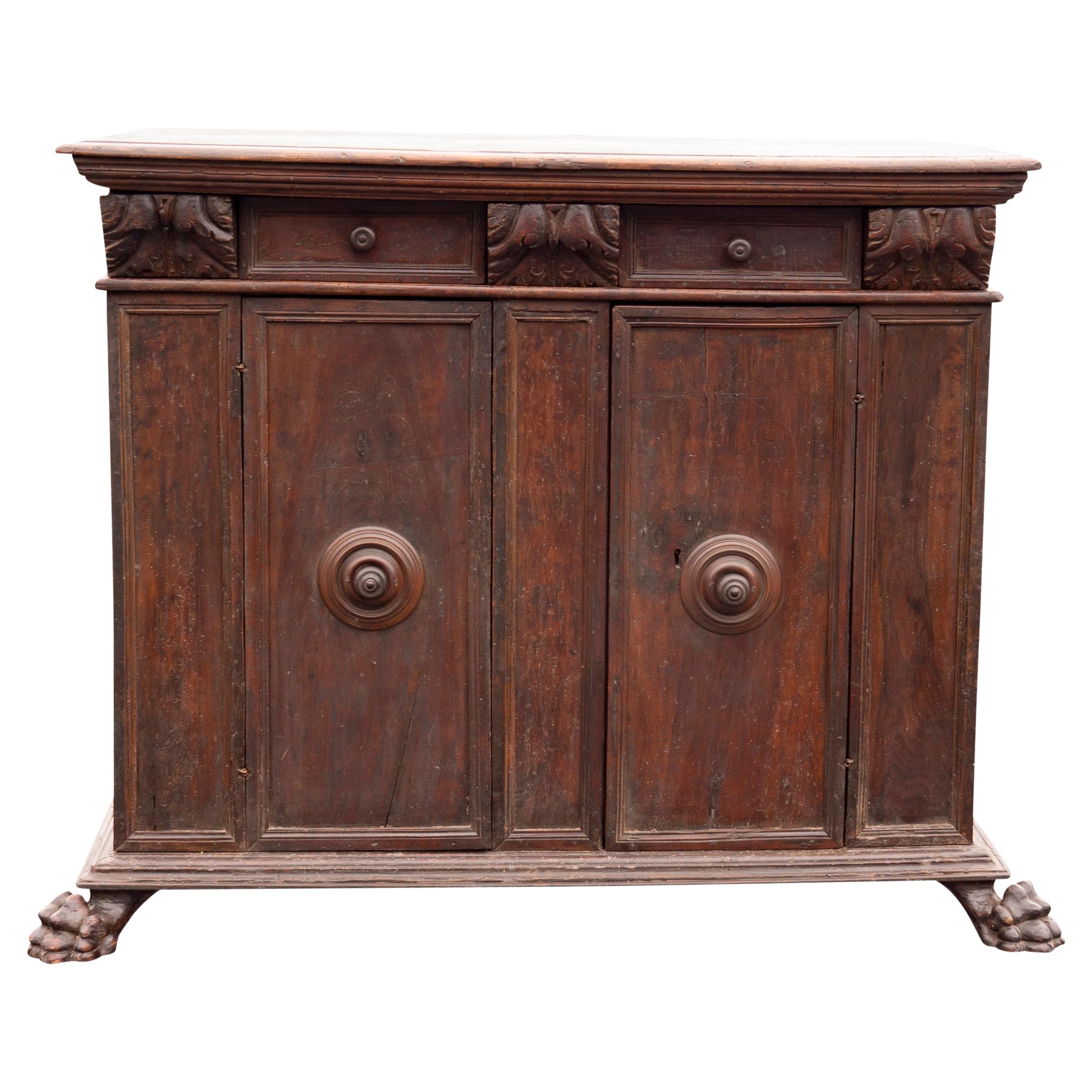Items Similar to Fontainbleau Renaissance Cabinet Bearing the Dodieu’s Family Coat-of-arms
Want more images or videos?
Request additional images or videos from the seller
1 of 6
Fontainbleau Renaissance Cabinet Bearing the Dodieu’s Family Coat-of-arms
About the Item
Fontainebleau renaissance cabinet bearing the Dodieu’s family coat-of-arms
Origin : ILe De France, School of Fontainebleau
Period : Second French Renaissance, Around 1560-1580
Light coloured walnut wood, egg-shell pastiglia, inlay of ebony
Good condition, usual restaurations
Everything in this cabinet brings to mind the rigour and elegance in vogue during the reign of the French king Henri II. This Renaissance cupboard finds its direct inspirations in works from Fontainebleau, made during the second half of the 16th century. Its strong structure is conceived as an imitation of architecture as we can see through the use of Corinthian columns and with the refined pediment.
Each drawers, the pediment and the lateral sides are enriched with blackened wood and pastiglia inlays. This technique originates from Italy and so are the delicate scroll motifs.
The lower body opens with two door-leaves and two drawers and stands on a moulded plinth with four bun feet.
The Second French Renaissance and the School of Fontainebleau
During the reign of the French king Henri II appears a style of furnitures strongly influenced by architecture. This taste for balance sets the bases of a French art. The cupboard, as a model of a building’s facade, uses modillions, feather-quills, columns, cornice and curved pediment. These combinations of architecural shapes is also applied to the ornaments : within the architectural rigour the decorative effect is very much alive.
The uprights of the lower body are adorned with veneered blackened wood motifs wisely located. They evoke the carpenters activities of the first Italian artists in France, famous for their marquetry flooring.
Within moulded frames each body’s door-leaves bear low-relief carvings divided in three areas. The door-leaves are centered by female figures barely dressed with a floating drape and facing each other in a pastoral landscape.
On the left Flora, the allegory of Spring, holds a bouquet and a cornucopia full of flowers.
On the right Ceres, the allegory of Summer and fertility, holds a cornucopia full of fruits and sheaves of wheat.
Above them are lying two female figures facing each other.
On these depictions Summer and Spring appearances match their traditional iconographies, defined through time and eventually written down by the author Cesare Ripa in his Iconologia published in 1603.
The theme of the seasons is very much used by the School of Fontainebleau but by reinventing the models : undressing the female figures -except Spring the other seasons were always depicted dressed- higlighting the supple lines of the bodies perfectly inscribed in their frames.
The influence of Jean Goujon is seen as much by the panel composition than by the themes chosen (seasons, nymphs, goddesses) or by the execution ; law relief figures, elongated canon, dancing moves.
Only the central motif between the drawers of the belt brakes this logic of representation, a strong lion’s head in high relief. Located in the center of the cabinet’s facade it emphasized the modillion’s volume place at the same height.
Mythological motifs also find their source in Fontainebleau’s production. Fantastic beasts, eagles about to fly off with their wings restrained by the rectangular frame.
The cabinet’s structure, its proportions, the design of the ornamental spaces match the models defined in Fontainebleau. The architectural composition is lightened up thanks to two important columns and to the ternary division of the decor. On the lower body the uprights are enriched with cartouche centered by sphinxes.
Sphinxes
Enigma has a name, a shape and a face inherited from antic mythologies. From Egypt to Greece the sphinx symbolizes serenity, vigilance, intelligence and voluptuousness. Beast with a female head and a lion’s body the sphinx seduced the Fontainebleau Renaissance. Indeed these artists were not imitating nature but interpreting, building on abstract rules with the pursuit of ideal beauty guiding them.
The crouched creature with its elongated neck bent backwards in an elegant curve is depicted with a regular face and large breast, attributes of open feminity, mixing erotism and preciousness.
Conclusion
Its decor and its division of the ornamental space are characteristic of the Second French Renaissance.
The cabinet is topped with a broken triangular pediment. In the center two columns frame a highly carved coat of arms. Above an entablature carries a pediment with volutes.
The door-leaves bear goddesses, female figures, fantastic beasts inspired by antiquity with a hint of Italian art. Female figures stand elegantly amidst their dancing drapes in a way close to Fontainebleau mannerism. This type of allegorical depictions of seasons was particularly in vogue during the second half of the 16th century. The charm of these figures seduced the patrons.
Perfect testimony of the French art with its refined decor, the rigour of its proportions and the suppleness of its crowning this cabinet can be compared with cupboards ordered to furnish royal palaces and castles. A time during which the furnishing of Chambord, Saint-Germain or Fontainebleau castles kept the worshops very busy.
This cabinet was beautifully made in the Loire Valley during the second half of the 16th century.
DODIEU Family
France, Lyon
The earliest record of the name DODIEU dates back to 1269. This year Thomas and Guillaume Dodieu sign the Truce between the Chapter of Lyon and the citizens.
All along the line, this family keeps a certain political and religous importance with the elections of many bishops and governors.
To draw a link between our cabinet and a member of the Dodieu’s family we have to reach the year 1524 and the 8th degree.
Claude Dodieu, was lord of Rivas and second son to Jacques Dodieu, the king’s secretary. Councilor of the court in 1524 he was promoted master of requests in 1529. Claude Dodieu was also sent as ambassador in Rome and followed emperor Charles V in Austria, in Spain, in Africa, in Naples and in Rome.
Claude Dodieu’s political status allowed him to attend the consecration of the queen Catherine de’ Medici at the Basilique Saint Dénis in 1549. He stays in Paris and have a seat to the 1557 State Assemblies.
The following year Claude Dodieu died in Paris and was buried in the 4e arrondissement, inside the church of the Pères Célestin nowadays destroyed. It was the second most important royal necropolis -after Saint Dénis- where many princes had been buried attesting the prominence of Claude Dodieu.
Claude Dodieu may have been the patron of our cabinet.
- Dimensions:Height: 95.08 in (241.5 cm)Width: 53.75 in (136.5 cm)Depth: 23.04 in (58.5 cm)
- Style:Renaissance (Of the Period)
- Materials and Techniques:
- Period:
- Date of Manufacture:circa 1560-1580
- Condition:
- Seller Location:Saint-Ouen, FR
- Reference Number:1stDibs: LU3115329553922
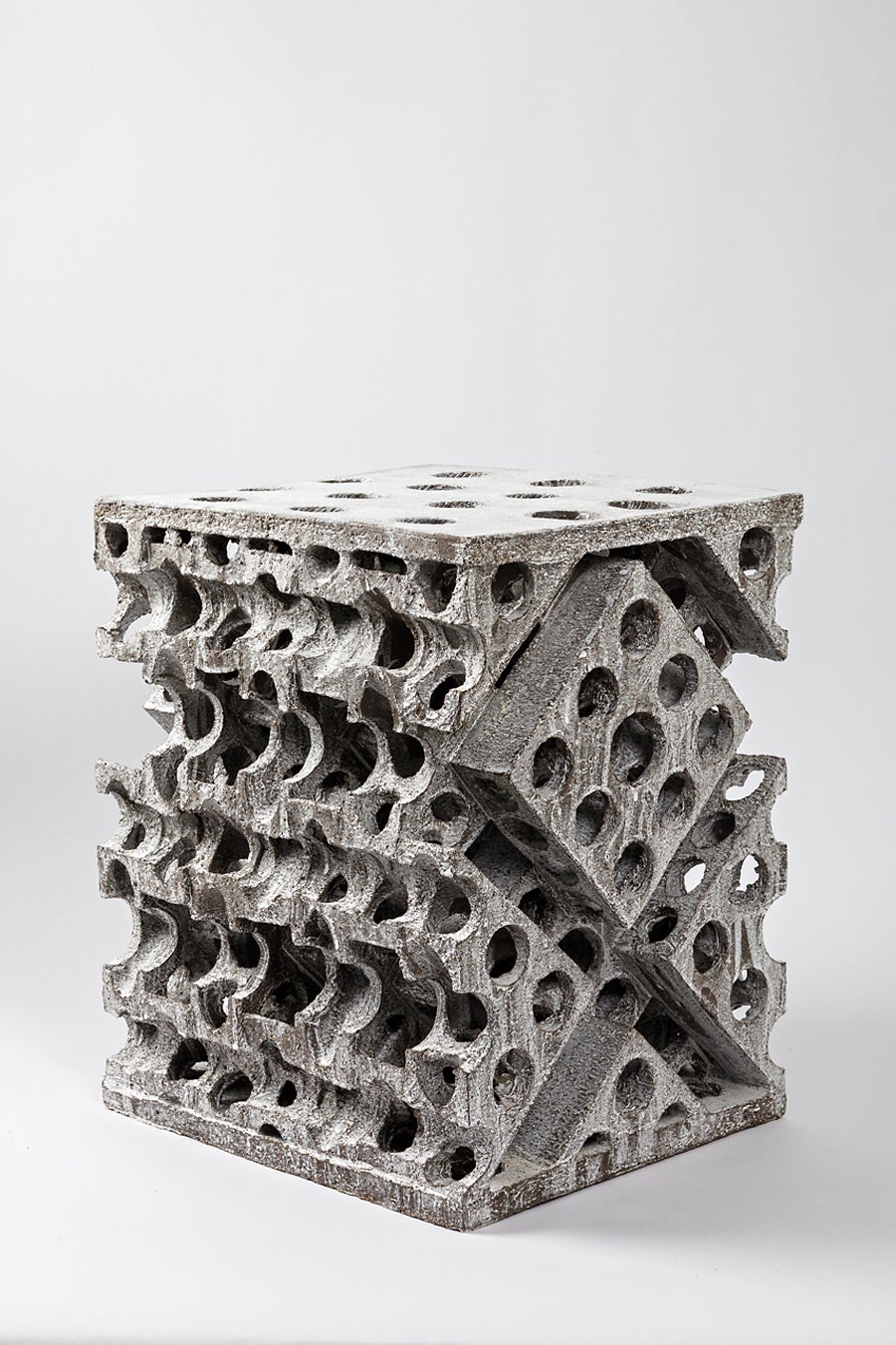
About the Seller
5.0
Vetted Seller
These experienced sellers undergo a comprehensive evaluation by our team of in-house experts.
Established in 2016
1stDibs seller since 2017
159 sales on 1stDibs
Typical response time: 7 hours
- ShippingRetrieving quote...Ships From: Saint-Ouen, France
- Return PolicyThis item cannot be returned.
More From This SellerView All
- Italian Renaissance Cassone with the Coat of Arms of the Bonfanti FamilyLocated in Saint-Ouen, FRThis Italian walnut chest called « cassone » is shaped as an antic sarcophagus. The beautiful patina and the plain lid bring to the fore the facade richly ornated with vegetal motifs...Category
Antique 16th Century Italian Renaissance Blanket Chests
MaterialsWalnut
- Burgundian Renaissance Cabinet Depicting the Four EvangelistsLocated in Saint-Ouen, FRThe cabinet’s upper body, slightly recessed is topped by an overlapping entablature and cornice supported both in the front and the rear by four fluted columns. The lower body stands on four squared feet and a moulded base. Each door-leaf’s panel is centred by a low-relief carving presenting one of the four evangelists...Category
Antique 16th Century French Renaissance Cabinets
MaterialsWalnut
- Small Renaissance CabinetLocated in Saint-Ouen, FRSmall renaissance cabinet ORIGIN : FRANCE PERIOD : END OF THE 16th CENTURY Measures: height: 167 cm length: 123 cm depth: 58 cm This small two-part unit with harmonious proportions opens with four front leaves and two belt drawers. It rests on a molded base. The uprights and the central frame of the lower body are adorned with long stylized palmettes. They frame the four leaves on which unfolds a vegetal decoration made of stems and leaves sculpted in symmetry around two mascarons topped with feathers...Category
Antique 16th Century French Renaissance Cabinets
MaterialsWalnut
- French Renaissance Cabinet with PerspectivesLocated in Saint-Ouen, FRThis Renaissance Cabinet reveals the great mastery of the Lyon workshops which are at the origin of its realization. Sculptors and wood-carvers worked here in symbiosis to express an...Category
Antique 16th Century French Renaissance Cabinets
MaterialsWalnut
- Rare Renaissance Cabinet Richly CarvedLocated in Saint-Ouen, FRThis rare Renaissance cabinet is richly decorated on the doors and drawers with carvings depicting the four seasons, and on the uprights and the entablature, alternating flower bouquets inlaid with mother of pearl. This is a beautifully conceived piece of furniture, representing a crowned portico with its entablature and cornice. The upper body Articulated separately in a ternary rhythm, as with the lower body, the upper part opens with two carved doors. The doors are framed by both the lateral uprights and the casing. There are cartouches carved into the casing in which mythological figures are depicted with flower bouquets. On the doors: On the right: Spring, a female figure crowned with a wreath of leaves, holding a basket full of flowers. She is wearing necklaces and bracelets on each arm, with drapery discretely wrapped around her body and is standing on a winged putti’s head. On each side are depicted a tree and a village with a steepled church. Above her head floats the three signs of the zodiac corresponding to the season: Aries, Taurus and Gemini. On the left: Summer, a bearded man crowned with ears of corn and bearing armfuls of corn. He is standing on a similar winged putti, flanked by a tree and an ear of corn. The following three signs of the zodiac appear: Cancer, Leo and Virgo. On the uprights and the central casing a number of smaller figures seem to represent virtues and vices that newly wedded couples should aspire to and avoid. On each side, at the bottom of the uprights, there is a dog representing fidelity. Above, a lion embodies power, wisdom, and justice. In between, on the left upright, there is a figure of noncombatant Athena wearing a helmet and holding a spear, an arrow pointing down and in her left hand, a shield, symbol of protective power. On the right upright, the goddess Venus controls the arrow of Cupid. The iconography here acts as a clear reminder of the required virtues that both parts of a young couple need to fulfill: fidelity, power, wisdom and justice. For him, the goddess Athena focuses on the power. Whereas for her, it is Venus who shows how to control Cupid’s arrow. On the central casing at the bottom, by way of contrast, there is a peacock, a symbol of pride and at the top, a monkey representing lust and mischief. In between, a woman holding a chain and a cup full of precious stones while on the floor sits a half empty opened casket. This can be interpreted as a symbol of extravagance. Above, the entablature, decorated with male figures resting on leaking urns, may symbolize the passing of time. They are flanked by two consoles decorated with acanthus leaves and separated by flower bouquets (inlaid with mother of pearl). Finally on top, a cornice acts as a crown for the piece of furniture. The lower body The moulded base stands on four round, flattened feet. Represented on the doors: On the left: Autumn, a stocky, naked man crowned with vine leaves, holding fruits in his right hand and with his left, picking a bunch of grapes from a climbing vine. Standing on a mound, he is surrounded by a vine and a hill, at the foot of which a man presses the grapes in a big vat after the harvest. Above the climbing vine appear the signs of Libra, Scorpio and Sagittarius. On the right: Winter, an elderly man wearing a fur cloak...Category
Antique 16th Century French Renaissance Cabinets
MaterialsWalnut
- Renaissance Cabinet form Lyon 'France'Located in Saint-Ouen, FRCondition : Partly dating from the Renaissance. The backs and the drawer’s insides have been re-done. Historical background The 16th century is a prosperous period for Lyon...Category
Antique 16th Century French Renaissance Cabinets
MaterialsWalnut
You May Also Like
- Renaissance CabinetLocated in Washington, DCA truly stunning cabinet with a rich patina. Made by a Swedish cabinetmaker in the early 19th century. The paint on the inside and the outside is all original. Original hardware includes the hinges, locks, key, straps. Intricate carved paneling.Category
Antique Early 19th Century Swedish Renaissance Cupboards
MaterialsIron
- Cabinet in the Renaissance Style, France, 1870Located in Chorzów, PLCabinet in the Renaissance style, France, 1870. Very good condition. Wood: Walnut Dimensions: height 233 cm, width 64 cm, depth 62 cm.Category
Antique 1870s French Renaissance Cabinets
MaterialsWalnut
- Pair of English Renaissance Stained Oak CabinetsLocated in New York, NYPair of English Renaissance style (19/20th Century) dark stained oak carved 2 door sideboard cabinets with Wainscot panels and drawer (PRICED AS Pai...Category
Early 20th Century Renaissance Sideboards
MaterialsOak
- Pair of Spanish Renaissance Style Mahogany CabinetsLocated in New York, NYPair of Spanish Renaissance style (19/20th Century) mahogany narrow cabinets with grill doors and red damask panel (PRICED AS Pair).Category
Antique Late 19th Century Renaissance Cabinets
MaterialsUpholstery, Mahogany
- Italian Renaissance Walnut CabinetLocated in Essex, MAWith a rectangular top with molded edge over a frieze with two drawers flanked by three acanthus carved corbel shaped drawers, pair cabinet doors below wi...Category
Antique 1650s Italian Renaissance Cabinets
MaterialsWalnut
- Renaissance Style Vitrine CabinetLocated in Los Angeles, CAThis Renaissance style vitrine cabinet is a stunningly beautiful masterpiece in white oak with superb carvings and detail. Note the fourteen carved figures, lion's heads and other su...Category
Antique 19th Century Italian Renaissance Vitrines
MaterialsOak
